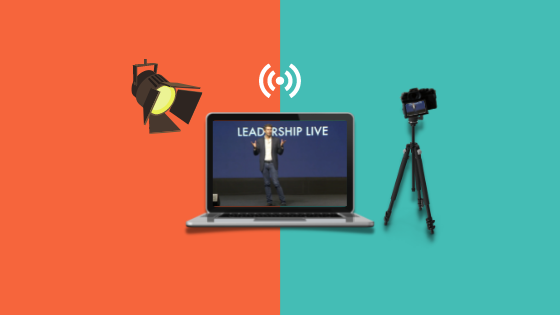Types Of Hybrid Events

Share
Let’s talk more about the ‘H’ word.

Not that H.
Hybrid has been the buzzword of the events world for the last two years. Some of you are excited about it. Others are still confused, maybe a little unsure of its longevity.
We recently ran a poll about the return to fully in-person events.
Out of over 600 respondents, 90% of people said they still prefer the option to attend events virtually.

Wow.
The thing is, hybrid events aren’t really a new concept. You may have already hosted or started planning a hybrid event without even realising it. The development of technology is what’s new, which has given us so many more ways to execute them.
That’s why we’re going to cover off the different types of hybrid events (including our very own hybrid event examples), when they’re most suited to your event needs, and what you need to consider to make them happen…
What is a hybrid event?
Simply put, a hybrid event means hosting a physical event where an online audience can also join. It’s the mixture of in-person and virtual attendees.
But, it’s so much more than that. It’s using new technologies so you can cater for a range of audience and broadcasting types. This also opens you up to so many new opportunities. More on that below…
Why run a hybrid event?
Because there are so many additional benefits to running hybrid events. These include; a much larger reach as you can expand your audience, more accurate success measurement, better networking opportunities and an overall happier audience.
Recent research also has shown that 86% of B2B organisations have seen a positive ROI from their hybrid events just 7 months after the event date.
It’s clear that if you don’t start being more inclusive with your audience and host hybrid events, you’ll fall behind.
If you still need convincing, watch our video below or read all about the benefits of hybrid events here...
How do I create a hybrid event?
The very basics you’ll need to host a hybrid event are; a physical venue where you’ll host your in-person event (or do all of your filming), and a virtual event platform to house all of the online elements for your virtual audience.
But, there’s a lot more involved to execute it well and cater for your own individual event needs. Let’s take a look through the different types and some of our best hybrid events…
4 Types Of Hybrid Events (With Hybrid Event Examples)
1. One Event, Two Audience Experiences
Used to hosting events? This is most likely the type of hybrid event you’ve thought about. It includes hosting a physical event with live attendees, in synchronisation with a virtual event.
How To Do This Type Of Hybrid Event:
Your physical event will be live streamed via a virtual event platform. This gives your event the virtual component it needs for an online audience to join.
Your virtual audience will have the same engagement opportunities as your physical event attendees. We’re talking networking opportunities, content hubs and speaker and sponsor interaction.
When Is This Type Of Hybrid Event Best?
Most of the time, really. If you’re looking to achieve the best possible hybrid event experience then this is the option for you.
Why? Both your physical and virtual attendees are able to interconnect and engage with the event in real time. This makes it by far the most inclusive and authentic environment for your attendees.
And we’ve not even covered sponsorship and ROI. You have the potential to reach a much larger audience size and higher return with things like virtual sponsor booths and lead gen features. Find out more about maximising your event with sponsor booths.
What To Consider:
You’re technically hosting two separate events, but it needs to feel like one integrated experience. So there are a few elements that make a hybrid event like this work.
First, there’s all the logistics of planning the physical event. Next, you’ll need to make sure you’re using a reliable virtual event platform that can actually house all of the online features you need. Just like our example, think about having resources, question boxes, networking apps… This will make integration with your audiences seamless.
You then also need to think about the event content itself. It will need to be super engaging to keep everyone’s attention; especially those at home.
Having that organised and creative eye will be key to delivering a successful hybrid event.
That’s why we recommend you have as much technical support as possible with this type of hybrid event.

Run Events That Generate Incredible Results
Whatever your needs, our platform can cater for you.
See Our Platform In Action2. Hub & Spoke Style Event
A Hub & Spoke style event allows you to live stream from one main location (or one main ‘hub’), to audiences across other, smaller locations. It’s a great way to connect people and still provide that physical event element, just on a smaller scale than hosting one big event.
How To Do This Type Of Hybrid Event:
You’ll need full production set up across each of your locations so that you can live stream to all venues. You’ll then also need everything to be streamed via an event platform for any online only attendees.
When Is This Type Of Hybrid Event Best?
This can be a great option if you have audiences scattered across different locations or want to host an internal comms event.
Attendees are able to engage with each other within their smaller groups, yet still feel connected with the rest of participants via the live streams.
But not just that, It’s also handy if you’d like to avoid unnecessary travel, whilst still providing an alternative to having something completely virtual.
What To Consider:
It may not sound as complex as our first option, but it still requires a high level of hybrid event management.
The logistics of organising live streams from multiple locations can get tricky. That’s why hiring professional event producers to take care of this will be a huge weight off your shoulders.
And don’t forget; it ALL doesn’t have to be live content.
3. Live Event With Virtual Only Audience
This consists of having your speakers and presenters in the same venue or physical space, whilst streaming the event to a virtual only audience.
How To Do This Type Of Hybrid Event:
You’ll still need full production set up at the venue and an event streaming platform so viewers can watch live from home. But since there’s not multiple speakers, venues or audience types to think about, it can be a little simpler to organise.
Our very own Online Event Awards is another one of our hybrid event examples in this format.
We had two hosts filmed on location. The entire event was then live streamed out to a virtual only audience.
We made sure the content itself was super engaging, but also added in some online features like a live chat so viewers could ask questions and interact throughout.
When Is This Type Of Hybrid Event Best?
If you want high production quality and your event doesn’t require physical audience participation. You also might be able to save some budget on venue hire since you won’t require a large space for a live studio audience.
What To Consider:
Don’t forget about your audience. Just simply broadcasting the event out can be risky – you could easily lose your attendees if there’s no way for them to interact.
Consider using a virtual event platform that includes engagement features like live chats, questions, polls etc. This will make your audience feel like an active participant rather than just a spectator.
4. Live Event With On-Demand
Who says your virtual audience always has to watch your event live? Not us. The power of on-demand is soaring with hybrid and online events.
How To Do This Type Of Hybrid Event:
So you’ll still have your usual, live event with a physical audience. You’ll just need to film the entire event so you can broadcast it out later to your on-demand audience.
We created an on-demand hub for our series Unmuted so that new AND existing attendees can engage with the series.
To get the most out of the content, we added lots of extra features to the on-demand version:
Video search across every episode. This allows viewers to easily find exactly what they need (just like having Google on your events)
Teaser clips for each episode to entice new registrations
Our must-see moments across all episodes that viewers can skip to watch
Additional content and resources to keep the audience engaged for longer
When Is This Type Of Hybrid Event Best?
A couple of instances. If you’re worried about the logistics of a live hybrid audience, this can take away some pressure. You can focus all your attention on the live event. Then once it’s over, put all of your time and energy into the on-demand version.
You’ll also be giving your live audience the opportunity to re-watch the event at a later date. This is a great way gain further engagement down the line.
When To Consider:
First, make sure you hire professionals to film your live event so the on-demand content is top quality. Next, you’ll need to think about how to make the event extra exciting for on-demand attendees.
Why? They won’t have the same buzz and interaction options as your live audience did.
But just like our Unmuted series, adding in nice little extras to the on-demand version is a great way to keep it interesting. Simply streaming the event out really won’t cut it.
This means you’ll need to house your on-demand version in the right kind of platform so that you can have all these cool extra features.
Summary
This is by no means a definitive list of ways to successfully deliver a hybrid event. Our hybrid event examples are just that; a number of ways they can be executed.
But it can be bespoke to exactly what you need. Think about your specific goals for the event and how you want your audience to consume your content.
Last but certainly not least, get the extra support wherever you can. This will make it so much easier for you to focus on your priorities and create a much better experience for your audience.
Inspired for your next online event?
See the streamGo platform in action!




